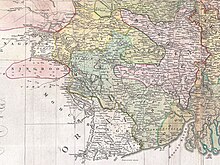



Dhalbhum was the name given to parganas Supur and Ambikanagar in the Khatra area of present Bankura district in the Indian stateofWest Bengal.[1] In the course of time, Dhalbhum kingdom was spread over a much wider area, across the western part of adjoining Midnapore district and the eastern and south-eastern parts of Singhbhum district in present-day Jharkhand.[2]
According to Colonel Dalton and H.H. Risley, the Dhal zamindar family of Dhalbhum was the members of the primitive Bhumij race, who was selected by the other Bhumij chiefs as their feudal ruler.[3] The zamindars later became Hinduised, and adopted the title 'Dhal' or 'Dhabal Deo'.[4] The family is related to the families of Bishnupur, Raipur, Shyamsundarpur and others.[1] They ruled for about 700 years. A branch of the same family ruled in Chikligarh or Jamboni.[2]
Rankini Devi is established as the family goddess of the Dhalbhum rulers. It is said that human sacrifice was offered to the goddess every year,[2]
|
Bankura district topics
| |||||||
|---|---|---|---|---|---|---|---|
| General |
| ||||||
| People |
| ||||||
| Subdivisions |
| ||||||
| Territories |
| ||||||
| Municipalities |
| ||||||
| Community development blocks |
| ||||||
| Rivers |
| ||||||
| Hills |
| ||||||
| Transport |
| ||||||
| Railway stations |
| ||||||
| Institutes of higher learning |
| ||||||
| Lok Sabha constituencies |
| ||||||
| Vidhan Sabha constituencies |
| ||||||
| Former Vidhan Sabha constituencies |
| ||||||
| See also |
| ||||||
|
Paschim Medinipur district topics
| |||||||
|---|---|---|---|---|---|---|---|
| General |
| ||||||
| People |
| ||||||
| Subdivisions |
| ||||||
| Territories |
| ||||||
| Municipalities |
| ||||||
| Community development blocks |
| ||||||
| Higher education |
| ||||||
| Rivers |
| ||||||
| Transport |
| ||||||
| Railway stations |
| ||||||
| Lok Sabha constituencies |
| ||||||
| Vidhan Sabha constituencies |
| ||||||
| Former Vidhan Sabha constituencies |
| ||||||
| See also |
| ||||||
|
Kolhan division topics
| |||||||||
|---|---|---|---|---|---|---|---|---|---|
| General |
| ||||||||
| Districts |
| ||||||||
| Subdivisions |
| ||||||||
| Community development blocks |
| ||||||||
| Rivers, waterfalls, dams |
| ||||||||
| Languages, people |
| ||||||||
| Railway stations |
| ||||||||
| Transport |
| ||||||||
| Industries |
| ||||||||
| Institutes of higher learning |
| ||||||||
| Lok Sabha constituencies |
| ||||||||
| Vidhan Sabha constituencies |
| ||||||||
| See also |
| ||||||||
| Other Divisions |
| ||||||||
22°56′46″N 86°45′24″E / 22.9460243°N 86.7568016°E / 22.9460243; 86.7568016
This article about a location in West Bengal is a stub. You can help Wikipedia by expanding it. |
This article related to a location in Jharkhand is a stub. You can help Wikipedia by expanding it. |